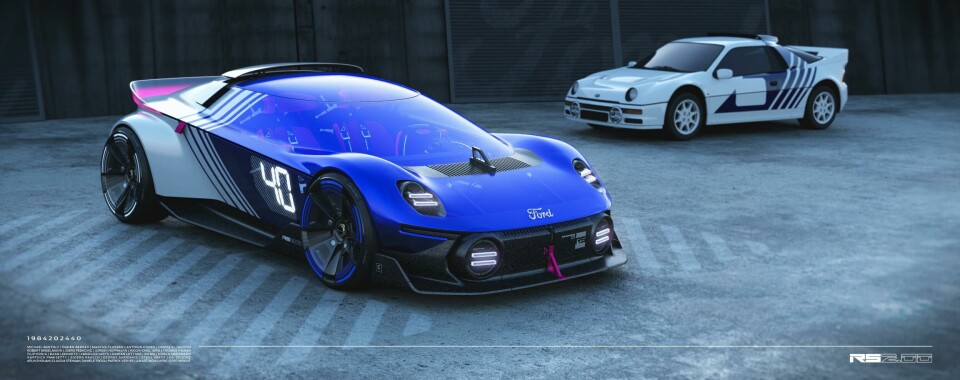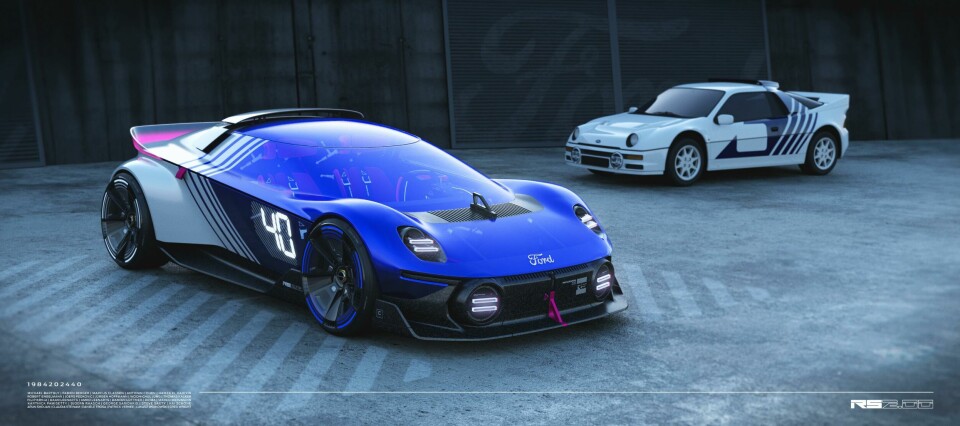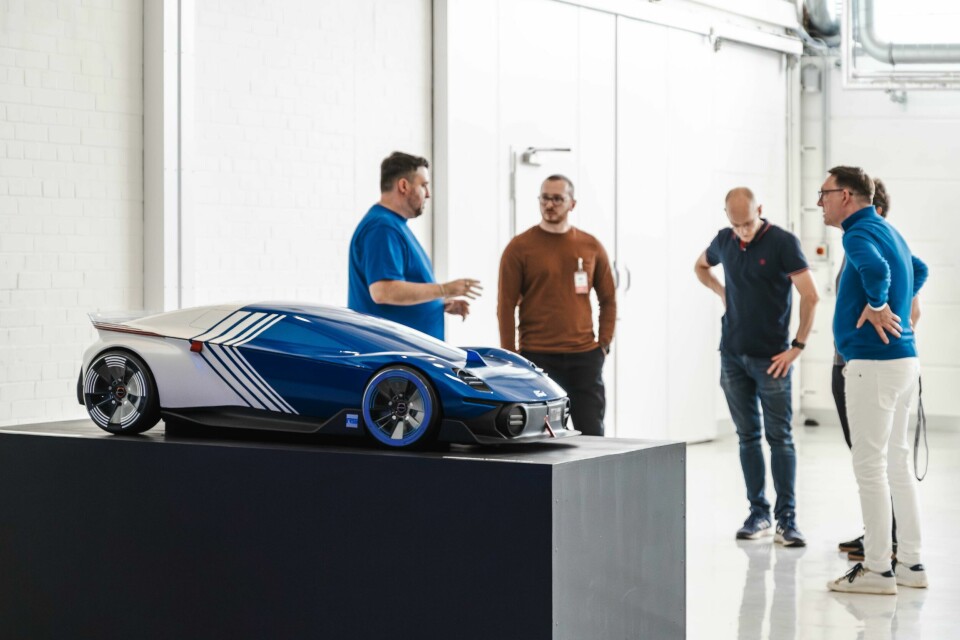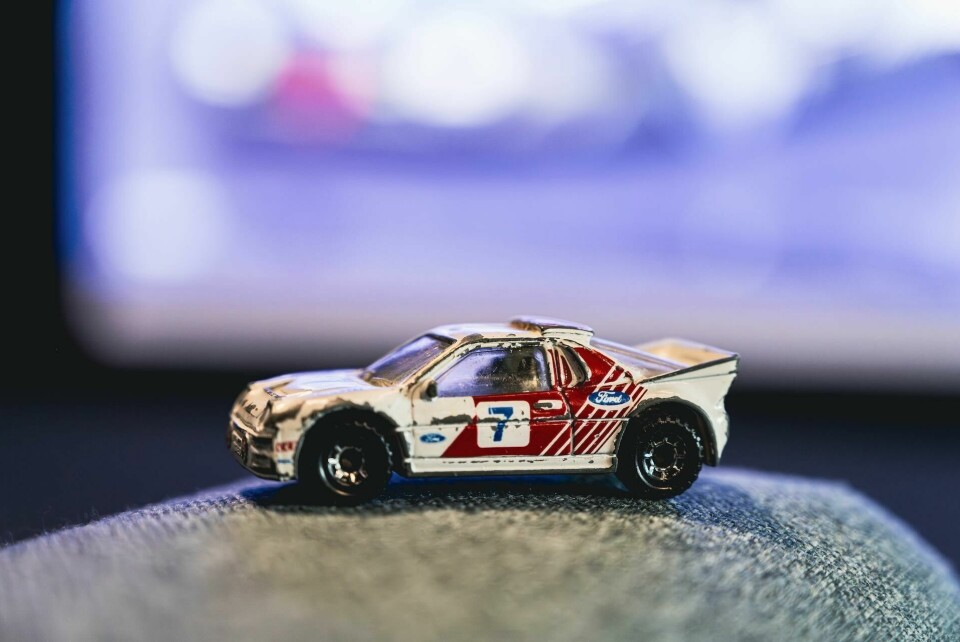
Exclusive: Ford of Europe designers go rogue to celebrate RS200’s 40th anniversary
Ford of Europe’s design team worked secretly to bring the iconic RS200 closer to new, younger audiences. Car Design News visited them in Cologne to find out more
Car design is generally seen as a creative art form, a chance to express oneself. The reality is not quite as rosy – this is a business after all, and not every idea, sketch or even working prototype will make the cut. There are always hoops through which to jump and stonewalling by senior figures. You don’t simply do what you want.
But in today’s digital age, designers do have a little more freedom to play, even if it is in secret. To celebrate the 40th anniversary of the iconic RS200, Ford of Europe’s team in Cologne took it upon themselves to have some fun and create what they see as its successor. Not a like for like – such as the ground-up reinterpretation from Boreham Motorworks – but something that speaks to the emerging generation of younger drivers.
“It was very much a case of designers going rogue,” design boss Amko Leenarts says. “They humour me with the impression that they can be controlled.” More on that later.

With a younger audience in mind, the so-called ‘Friendly Monster’ is a digital concept only for now, albeit we did see a scale model on our visit to the studio earlier this year. It is very much a futuristic expression and perhaps speaks to the company’s mentality, having explored how the Capri might look if it remained in production. The same thinking happened here.
For those of you tutting, rolling eyes or experiencing a sharp intake of breath, it is worth studying the render above that compares new and old. The proportions and packaging are familiar, as is the sharp shoulder line and boot spoiler, round fog lights, striped livery and flared arches. The key elements are there. But this is missing the point. It is not intended to reflect the next generation of the RS200, but many generations down the line in a hypothetical future.
“We have a much broader vision,” says exterior designer Michael Barthly. “We want to bring new groups into the Ford brand who maybe don’t have an emotional connection with it.”

Rather than sitting on a stand at Geneva (RIP) or Paris, the team would love to see the RS 2.00 (“two point oh”) launched through a videogame. And not Gran Turismo or Forza, but something like Fornite or Overwatch. Again, playing to a different crowd than the enthusiasts who would be clamouring for something more traditional.
Everybody was involved in the design beyond their disciplines
It is easy to see how this could be a hit and the quality of the renders do a wonderful job of showcasing the concept. Indeed, for a project that was put together as a side hustle, the range of materials created is impressive – from detailed storyboards and trend forecasting right through to artwork that aims to mimic the style of wall posters from the 1980s. A lot of work, but by all accounts the team loved every second.
“It’s purely from our gut. We’re car design enthusiasts,” says Barthly. “We also want to show what we are about as a design studio and express our creativity. It’s an under the radar skunkworks project and the team has had such an incredible dedication doing it in their own time, starting with sketches, and in no time there was a full 3D model.”
It is at this point during the presentation – hosted by designers of varying seniority but not Leenarts – that sketches from interior designer and People Awards shortlistee Robert Engelmann pop up. “We couldn’t stop him sketching,” Barthly jokes. ”The most popular cars in gaming have a working interior,” explains Engelmann, “so we had to do that properly.”
Most striking is arguably the pink boot spoiler and domed glasshouse that blends into transculent body panels. The latter is in fact all one unit – opening forward “clamshell style” from the back of the roof to the top of the front grille, taking the steering wheel with it in the process. The pink theme continues inside, with accents on the seat and steering wheel, which moves as one with the roof-bonnet combo. The doors feature an outward-facing digital display that shows the driver number, again a nod to the gaming theme.
Let’s wind back a little. It all began with an exercise to support a book being written by Steve Saxty, which would celebrate cars wearing the RS badge. To close out the book, Secret Fords, some of the Ford designers were asked to give their take on how a future RS200 might look. Little did their boss know that work continued even after the project had been wrapped up – they wanted to take it further. Leenarts did eventually find out, but stayed very much at arm’s length and left them to it.
With a blank slate, part of the challenge was figuring out what to do. Sometimes, this level of freedom can be more difficult than tackling something with specific boundaries or targets. As such, there are lessons to learn in design strategy beyond the concept itself.
Legends don’t die, they respawn
What’s particularly interesting is that team members did not stick to their own areas of expertise, working more like students in a way and blurring the lines between their formal job roles, listed below. “Nobody was limited to their specialist skills but rather working cross-functionally,” says Barthly. “Everybody was involved on all of the design aspects beyond their disciplines.” We wonder if this might flow through to future projects at Ford or inspire other teams elsewhere to give it a try. “It’s helped us to work together better, for sure,” notes Leenarts.
The RS2.00 will undoubtedly meet its share of criticism from purists. Indeed, despite convincing arguments made by the design team, the concept would still resonate more deeply as a working prototype; nothing made me want a car in real life more than racing simulators like GT Prologue. We did ask, and the RS2.00 is staying digital.
But perhaps times are changing and projects like these are ways to connect with new audiences, new drivers and to try new things from the comfort of the sofa. Barthly likens it to a modern song that samples an old hit. “We used the word ‘remix’ a lot during the process as it is not meant to appeal to the original fanbase of the RS 200,” he explains. “Yes there is an original car, but you can still judge [this new one] as its own object.” In a nod to gaming, the phrase ‘legends don’t die, they respawn’ is a clever way of putting it.

There is a distinct element of “why not” or “so what” about this project. Not in a way that dismisses the gravity of the RS200 in Ford’s heritage, but in a way that celebrates the joy of designing cars. After all, when there is no brief, no red tape and no production hurdles, why wouldn’t you experiment and have fun?
“The water has not been muddied by any corporate input,” concludes Barthly, “and it is so rare to be able to do this. We think this will remain a once in a lifetime project. But let’s see.”




















































